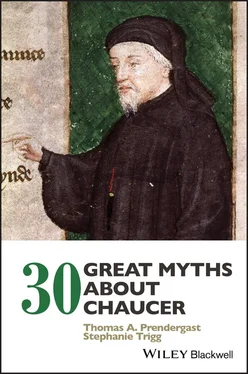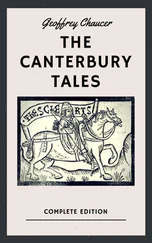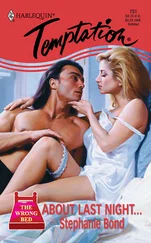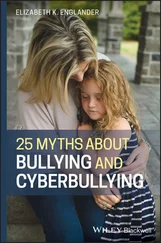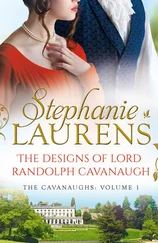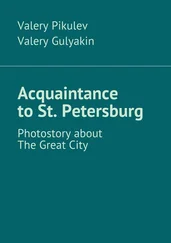9 9Edward Condren , “The Historical Context of the Book of the Duchess: A New Hypothesis,” Chaucer Review 5, no. 3 (1971), 195–212 , here 208.
10 10J.M. Manly, “Chaucer and the Rhetoricians: Warton Lecture on English Poetry, no. 17, read before the British Academy June 2nd, 1926,” Proceedings of the British Academy 12 (London: Humphrey Milford, 1926), 110. This is often misquoted as “thin prettiness.”
11 11Derek Pearsall , The Life of Geoffrey Chaucer: A Critical Biography (Oxford: Blackwell, 1992), 84.
12 12The Chandos Herald described her as “Que bêle fut, plesante et sage” in his life of Edward, Prince of Wales, written some time between 1376 and 1387. See Le prince noir poème du héraut d’armes Chandos: texte critique suivi de notes par Francisque‐michel (London: J.G. Fotheringham, 1883), 106: “A une dame de grani pris / Qui de s’amour l’avoit espris, / Que bêle fut, plesante et sage” (ll.1586–8). Froissart refers to her “en son temps la plus belle de tout la roiaulme d’Engleterre et la plus amoureuse” (II:243).
13 13Stephanie Trigg , Shame and Honor: A Vulgar History of the Order of the Garter (Philadelphia, PA: University of Pennsylvania Press, 2012), 27.
14 14Ibid., 65; Leo Carruthers, “‘Honi soit qui mal y pense’: The Countess of Salisbury and the ‘Slipt Garter,’” in Surface et Profondeur: Mélanges offert à Guy Bourquin, ed. Colette Stévanovitch and René Tixier, Grendel 7 (Nancy: AMAES, 2003), 221–34, here 232.
15 15Anya Seton, Katherine (1954; London: Hodder and Stoughton, 2006).
16 16Ibid., 45.
17 17See, for example, Duane Crowley’s Riddle Me a Murder (Manchaca, TX: Blue Boar Press, 1986), whose plot depends on a brief romance between Chaucer and Blanche that led to the birth of Henry Bolingbroke, the “son” of John of Gaunt who would become Henry IV. See also Myth 27 about Chaucer’s deathbed retraction.
18 18Pearsall, Life of Geoffrey Chaucer, 83, n.37. Pearsall is referring to Godwin’s Life of Geoffrey Chaucer and George Williams’s A New View of Chaucer (Durham, NC: Duke University Press, 1965). More specifically, he rejects outright the idea that The Book of the Duchess was written uninvited by Gaunt: “The poem could hardly have been written without Gaunt’s knowledge, and it is natural to assume that it bespeaks a certain intimacy. A young pipsqueak of an esquire would not have presumed to write on such a subject in such a way had he not been assured of a sympathetic reception” (84).
Myth 4
CHAUCER’S MARRIAGE WAS UNHAPPY
In 1931, England’s poet laureate, John Masefield, reported:
We gather from the poems that Chaucer’s own marriage was one of the utmost and liveliest unfortunate horror. The Wife of Bath describes her fifth marriage as being to much such [sic] a Clerk as Chaucer’s description of himself. Can it possibly be that the Wife of Bath is a portrait of Mrs. Chaucer? 1
This is one of the more extreme cases of collapsing the words that Chaucer uses in his public poetic productions with his private life, but it is hardly unique. Towards the end of the nineteenth century, J.W. Hales, quoting a couple of lines from the envoy to the Clerk’s Tale (“O noble wyves, ful of heigh prudence, / Lat noon humylitee youre tonge naille,” IV.1183–4), says, “It seems impossible to put a pleasant construction on these passages. It is incredible that they have no personal significance. The conclusion clearly is that Chaucer was not happy in his matrimonial relations.” 2 It is unclear precisely when historical thoughts about Chaucer’s marital status and his poetic musings about marriage were collapsed, but the prolific nineteenth‐century editor of Chaucer, F.J. Furnivall, was certainly responsible for the currency of the myth. In 1871 he makes one of those offhand comments for which he is so notable:
Poets are curious cattle about love and marriage. They can have a love or many loves quite independent of their wives: as indeed can and do many other men. If Chaucer’s wife was not a bit of a tartar, and most of his chaff of women meant for her, I have read him wrongly. 3
Suspending, for a moment, commentary on the sexist implications of this quotation, it is clear that Furnivall, Hales and Masefield all were engaged in broader reading practices of the nineteenth and early twentieth centuries that understood poetry as biographical. And it is perhaps unremarkable that both Masefield and Hales locate their evidence for Chaucer’s unhappy nuptials in the Canterbury Tales , in which Chaucer himself is a character. 4 But is there any basis for this belief?
It is first important to understand what drove critics to look almost exclusively to Chaucer’s poetry when talking about the poet’s marriage. We have very few historical records that deal with Chaucer’s marriage to Philippa de Roët. We do not possess any private correspondence between them and we are not even sure when they were married. An enrolment of letters patent tells us that Edward III granted an exchequer annuity to a Philippa Chaucer on 12 September 1366, so Geoffrey and Philippa must have been married either before or by that date (provided her maiden name was not Chaucer). 5 Most critics now believe that she was the sister of Katherine Swynford, John of Gaunt’s mistress (see Myth 3). She served in the household of the queen, and then in the household of the Duchess of Lancaster, Constanza (Gaunt’s wife), and is described as ascending to domicella (the female equivalent of a knighthood). Marion Turner emphasizes the family connections between Chaucer’s family and Gaunt’s household, remarking that the children of these four couples (John of Gaunt and Blanche; Katherine and Swynford; Gaunt and Katherine; and Philippa and Chaucer) all “seem to have spent a lot of time together as children in various Lancastrian great houses.” 6 This is a useful reminder that the medieval “household” was a far more fluid concept than the modern nuclear family; and that the relationship between living and working arrangements might also be more fluid.
It also seems quite likely that Chaucer and Philippa spent long periods living apart, but it is unlikely that they were estranged, as Philippa’s annuity through the early 1380s most often designated her husband as the payee. 7 She is last mentioned in the payment of her annuity on 18 June 1387. The absence of her name in the record of a payment to Chaucer of his Michaelmas installments on 7 November 1387 suggests that she had died somewhere in between. The couple had two sons, Thomas and Lewis (though see Myth 5), and probably a daughter, Elizabeth, who was nominated in 1377 by John of Gaunt (acting on behalf of his nephew King Richard, only ten years old at the time) as a novice to the convent of St Helen’s Bishopsgate. In the same year, Gaunt also nominated Margaret Swynford, the daughter of Katherine (Chaucer’s sister‐in‐law), to Barking Abbey in Essex. 8 Elizabeth moved to Barking after four years, possibly after the death of her grandmother.
This is the extent of our external historical knowledge of the marriage, though many critics believe that Chaucer makes a reference to Philippa in The House of Fame . In Book II, after narrating how he had fallen into a stupor, Chaucer tells us that an enormous eagle caught him up in his claws
And called me tho by my name,
And for I shulde the bet abreyde,
Me mette “Awak,” to me he seyde
Ryght in the same vois and stevene
That useth oon I koude nevene;
And with that vois, soth for to seyn,
My mynde cam to me ageyn,
For hyt was goodly seyd to me,
So nas hyt never wont to be.
(Iines 558–66)
Is the “vois and stevene” of “oon I koude nevene” an indirect reference to the voice of his wife? It is tempting to think so. Certainly, the distinction between the tone of the Eagle and Philippa’s voice has led some to claim that this is evidence of Chaucer’s being a “henpecked husband.” Further, they claim that Chaucer begins his dream‐vision with a direct reference to his harried status as he makes a pilgrimage to “the corseynt Leonard.” St. Leonard was the patron saint of prisoners, so critics have traditionally understood this as a reference to marriage as a prison – a reading that seems to be supported by a humorous invocation of St. Leonard that Chaucer might have known from Jean de Meun’s Roman de la Rose .
Читать дальше
